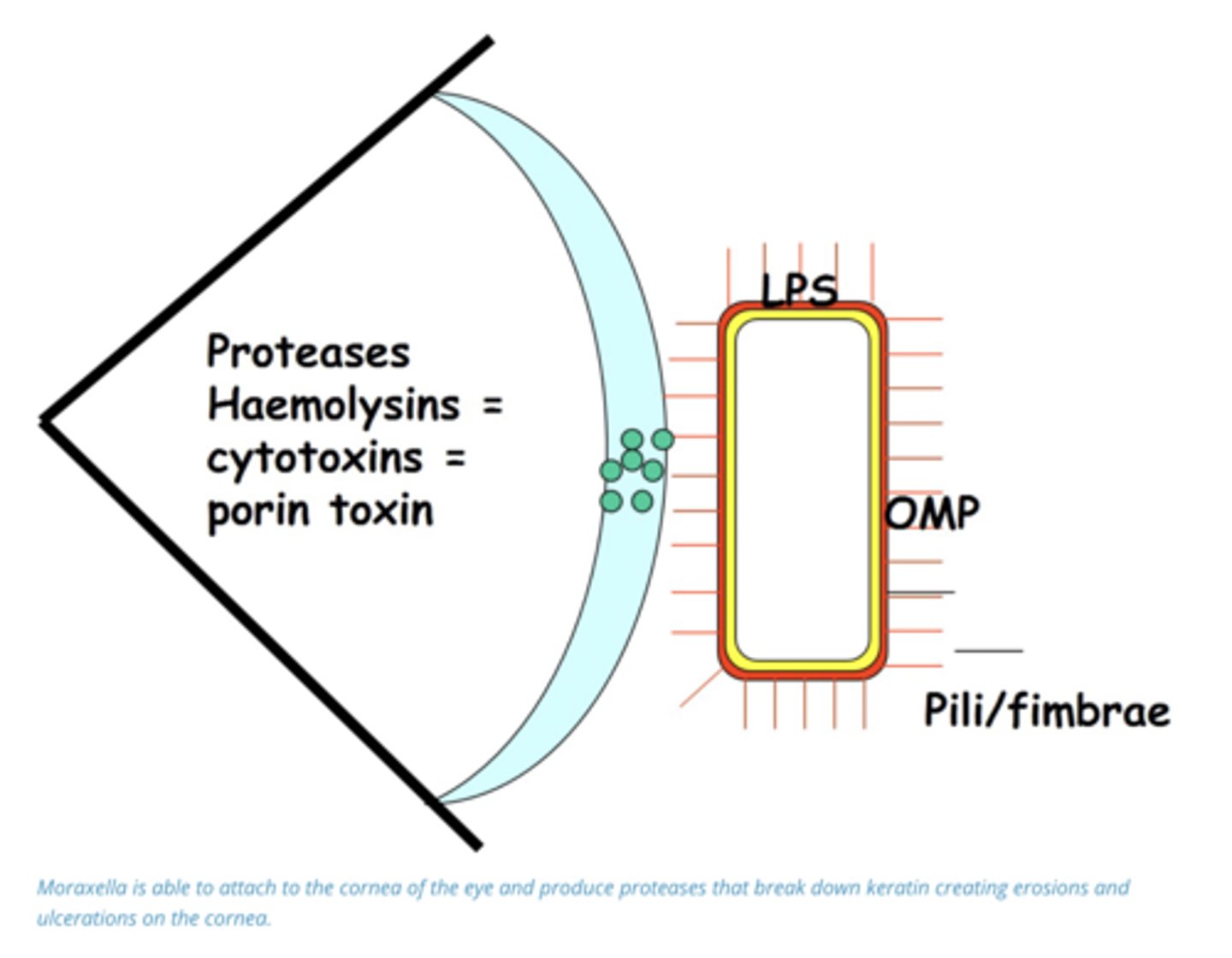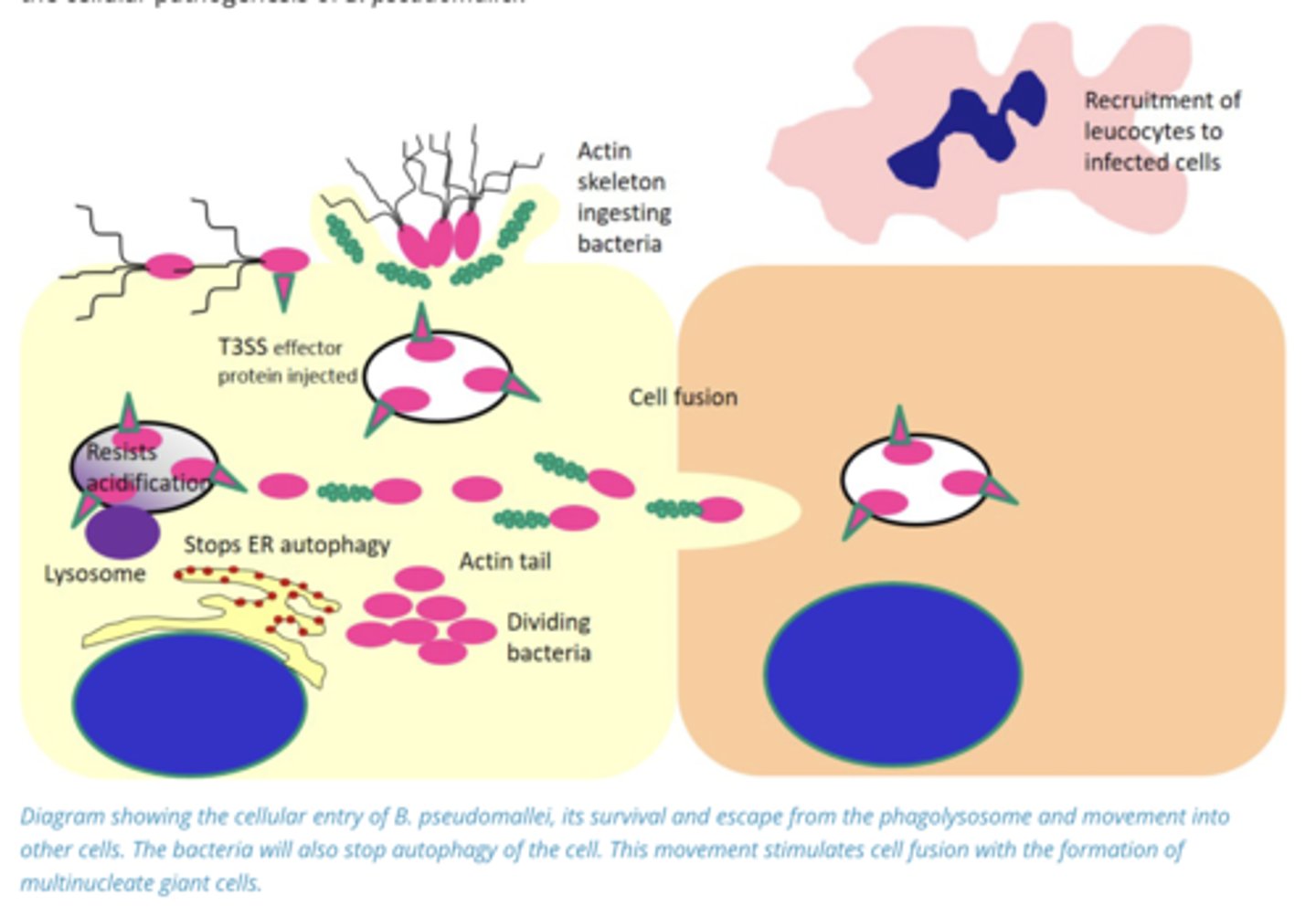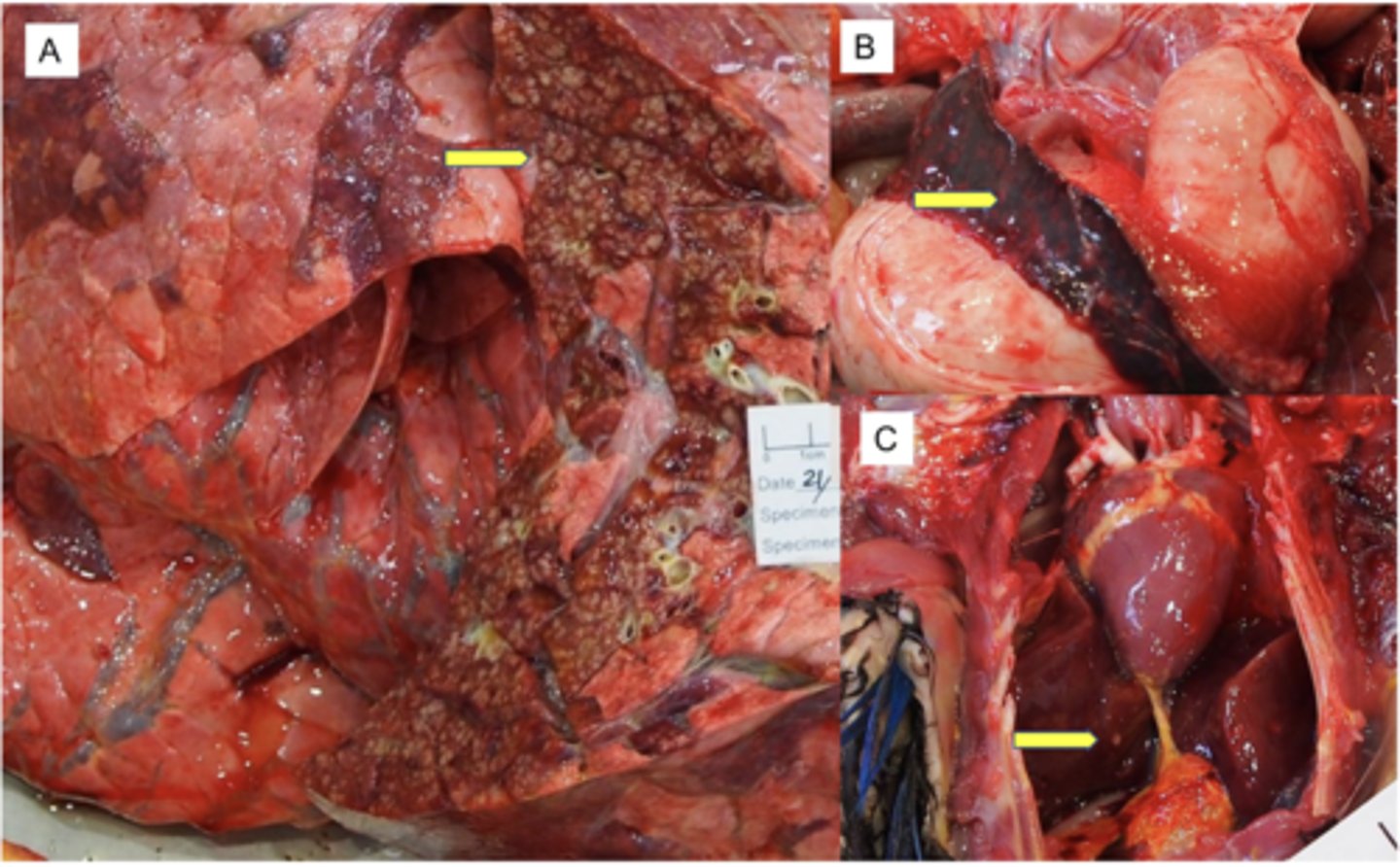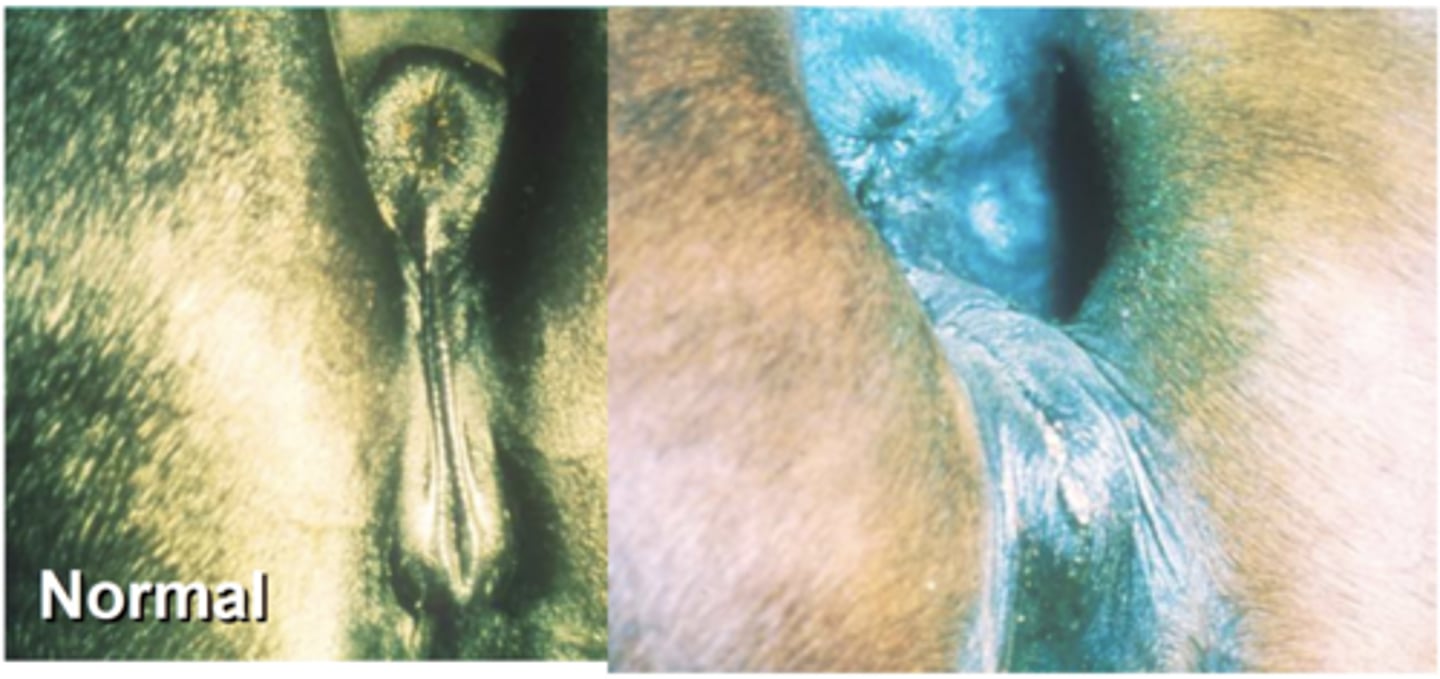ID 13: Melioidosis, Pink-Eye and Other Infections Caused by non-fermenting Gram Negative Bacteria
1/17
There's no tags or description
Looks like no tags are added yet.
Name | Mastery | Learn | Test | Matching | Spaced |
|---|
No study sessions yet.
18 Terms
Describe the Following Important non-fermenting Gram -ve bacteria:
1. Pseudomonas Aeruginosa
2. Acinetobacter spp.
3. Moraxella spp.
4. Francisella tularensis
5. Burkholderia mallei
6. Burkholderia pseudomallei
1. Opportunistic Pathogen, Common Cause of antibiotic resistant Chronic, Recurrent Otitis in dogs
2. Environmental bacteria implicated in nosocomial infections
3. Occur naturally in nasal and conjunctival mucosa causing eye infections including “Pink Eye” in cattle
4. Causes tularaemia
5. Causes Glanders in horses
6. Cause of Melioidosis, endemic to the tropics
Describe Tularemia (Francisella Tularensis):
Rare Zoonosis: Occurs from bites from ring-tailed possums
Describe Glanders (Burkholderia mallei) in terms of:
1. Animals Affected
2. Disease Consequences
3. Pathogenesis
4. Diagnosis
5. Control
1. Usually effect equids, but can infect humans. Notifiable Disease
2. Causes Nodules and ulcerations in the Upper respiratory tract and lungs
3. Similar Pathogenesis to Melioidosis, However resident in Recovered Horse respiratory system (Carriers) and Not soil
4. Culture and qPCR and Serology
5. Detection and Euthanasia,

State which of the Following diseases are notifiable and their current disease status in Australia:
1. Fransicisella Tularensis
2. Burkholderia mallei
3. Taylorella equigenitalis
1. Notifiable, Rare-Low virulence strain in Australia
2. Notifiable, not in Australia
3. Notifiable, Not in Aus
Describe Pseudomonas Aeruginosa in terms of:
1. Bacterial Properties
2. Infection is Common in What Injuries
3. Causes What Diseases
4. Treatment
1. Non-fermentative Ubiquitous Freshwater motile rod that infects wounds and damaged tissue, Produces green pigment (pyoverdin) and produces ketones that make it smell like apple cider. Due to temp tolerance, it can infect a wide host range
2. Infects burns/surgical sites
3. Canine Otitis Externa, Endometriosis in mares, and surgical site infections. - During wet conditions, it can cause a mild dermatitis and fleece discolouration in wooly Sheep
4. Treat with floroquinilones, aminoglycosides, beta-lactmas, Polymixin B

Describe Bovine Keratoconjunctivitis (Moraxella Bovis, IBK, Pink eye) in terms of:
1. Transmission
2. Pathogenesis
1. Carried by other animals, transferred between cattle via flies/Rubbing irritated eye against post/short distances via dust
2. Targets Cornea of the Eye → Produces hemolysins → Erode cornea → bacteria Entry → Inflammatory Response → Ocular Pus → Corneal Ulcers

Describe Bovine Keratoconjunctivitis (Moraxella Bovis, IBK, Pink eye) in terms of:
1. Clinical Signs
2. Diagnosis
3. Treatment
1. Tearing eyes, Shutting eyes as photosensitive, Dusty conditions exacerbate Problem, Blindness,
2. Fluorescein in eye to detect ulcers, Culture and identification of Moraxella Bovis. Multiplex PCR.
3. Lesions less than 5mm heal spontaneously, Subconjunctival injection of antibiotics, Eye patch to protect eye, put in shade, Limit dust, Isolate animals, Thick cloxacillin eye ointment, suture 3rd eyelid shut

Describe Melioidosis (Burkholderia Pseudomallei) in terms of:
1. Bacterial Properties
2. Where Bacteria are found
3. What Bacterial Infection Causes
1. Gram -ve non fermentive rod
2. Soil Inhabitant, especially during the rain season. Endemic to tropical North QLD
3. Causes "Melioidosis", a chronic granulomatous disease of the skin, respiratory tract, and other internal organs
Describe the Epidemiology of Epidemiology Melioidosis (Burkholderia Pseudomallei)
All Mammals are susceptible (Especially goat, Alpaca, Koalas), cases more common in the warm, rainy seasons when the bacteria which usually live at a depth of 30-60 cm in the soil, are brought to the surface by run-off, flooding, and soil excavation → Bacteria Accumulate in rain washed soils in low lying areas
Describe the Pathogenesis of Melioidosis (Burkholderia Pseudomallei)
Burkholderia Pseudomallei enters body via the respiratory, oral, and percutaneous routes → Attaches to Macrophages → Enters cells by causing cytoskeleton Change via T3SS effector → Phagocytosed → Escapes phagosome into Cytoplasm → Replicates → Moves to adjacent cell using actin tail → Inflammatory and Necrosis Response → Granulomas with Giant Cells, and Ulceration

Describe the Diagnosis of Melioidosis (Burkholderia Pseudomallei)
Presence of Multifocal abscesses/granulomas in various Organs in post mortem. Intracellular gram-negative rods in affected tissues. Grows well on common lab media

Describe the Treatment/Control of Melioidosis (Burkholderia Pseudomallei)
No Vaccines, control by reducing contact of susceptible animals with the bacterium during high risk periods. Feed animals off the ground during heavy rains, Move animals to higher ground to avoid run off containing bacteria
Describe Bordetella bronchiseptica in terms of:
1. Where Bacteria is found
2. What bacterial infection Causes
3. Animals Susceptible to Infection
4. Transmission
1. Commensal of upper respiratory tract in Animals,
2. Causes upper and lower respiratory diseases. Recognised as a cause of disease in dogs as part of kennel cough syndrome.
Causes Contagious Tracheobronchitis in Dogs.
3. Animals in large groups affected (shelters, kennels, catteries)
4. Transmitted via saliva/nasal secretions, Lives 1-2 weeks in moist environment and can spread via air-conditioning. Animals in large groups affected (shelters, kennels, catteries)
Describe Bordetella bronchiseptica in terms of:
1. Pathogenesis
2. Diagnosis
3. Control
1. Colonises upper respiratory → attaches to cilia causing ciliastasis → Descend to lower respiratory tract → mild fever, sneezing, a dry hacking cough and watery nasal discharge. Young and immunocompromised animals may develop a bronchopneumonia.
2. Transtracheal wash ideal, Bronchoalveolar lavange
3. Vaccination Isolate Animals, Keep animals in small groups,
List the Agents that most Commonly Cause Infectious Endometritis in Mares
Taylorella equigenitalis: Causes Contageous Equine Metritis (CEM). Not in Australia and Notifiable
Streptococcus equi subsp. Zooepidemicus:
Escherichia coli:
Klebsiella pneumonia:
Pseudomonas aeruginosa:
Describe the Epidemiology of Infectious Endometritis in Mares
All Species can move via ascending infection into the uterus or be deposited into anterior vagina via venereal transmission. Not all mares develop endometritis, Critical to the disease is the presence of an open cervix and anatomical defects in the perianal area allowing gaping of the vulva (Occurs as mares age/have poor Body Condition), allows urine pooling in vagina

Describe the Pathogenesis of Infectious Endometritis in Mares
Bacteria Enter endometrium → attach to epithelium → Grow/produce toxins → Endometriosis → fluid in uterus → Failure to conceive + early abortion
Describe the the Tests Required to Diagnose CEM and Detect Carrier Horses in terms of:
1. Screening Methods
2. Diagnosis
3. Detection of Carrier Horses
4. Control
1. Need to be Screened via entry into Australia by sampling external genitalia (Stallion) and Serology (Mares)
2. Culture from swabs from endometrium in mares and external genetalia in stallions. 3 Negative tests collected at weekly intervals are required to demonstrate freedom
3. Mares in Oestrous: 3 Swabs (Clitoral sinus, clitoral fossa, cervix), Stallions: 3 Swabs: Anterior urethra, urethral fossa, diverticulum
4. Eradicate agent: Stop Breeding, Quarantine,